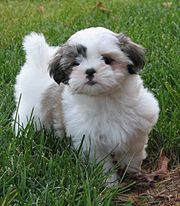Your Shih Tzu Puppy’s First Bath Time
By Connie Limon
Do not wait too long to start grooming your Shih Tzu. It is har d to make brushing a positive experience if you wait until your Shih Tzu is matted and start by yanking out the mats and tangles. If this becomes necessary, carefully clip out mats, then begin working with your mat-free Shih Tzu to acclimate it to grooming.
d to make brushing a positive experience if you wait until your Shih Tzu is matted and start by yanking out the mats and tangles. If this becomes necessary, carefully clip out mats, then begin working with your mat-free Shih Tzu to acclimate it to grooming.
When you use scissors to remove mats, snip a few hairs at a time. Be sure you have clearance between the mat and the skin. If your Shih Tzu puppy is too wiggly to do this safely, please seek the help of a professional groomer.
Do not bathe your Shih Tzu puppy too frequently. You will risk drying out its skin and coat. Bathe your Shih Tzu puppy no more than once weekly and every two weeks if possible.
Create a positive association with bath time using the following steps:
1. Let him hop into his bathtub to eat treats you toss on the tub floor (without water in the tub). You can also place him in the tub if he cannot jump into the tube and feed him treats. Provide a nonskid surface on the tub floor.
2. To accustom your Shih Tzu puppy to towels try touching him, then rubbing him with the corner of a towel and feed him a treat. Gradually work up to more vigorous toweling. No water at this time.
3. Introduce the blow-dryer by starting with a handheld pet or human dryer set on low and hold a few feet away from him, turned so it does not blow on him. Feed treats during the process. Gradually bring the dryer closer and start by moving the air across his toes, then his legs. Continue until he is accustomed to the warm air blowing all over his body.
4. While he is standing in the tube, soak a sponge in warm water and dribble it over him. Allow your Shih Tzu puppy to shake it off, and then offer a treat. Gradually work up to turning the faucet on and allow him to stand in the water. Gently begin hosing him with the warm water.
5. Take a small amount of dog shampoo (I strongly recommend using HealthyPetNet shampoos instead of human shampoos). Lather a small part of his body. Rinse. The next time you are at this step, increase the soaping and rinsing until you are bathing the entire dog.
If you will follow these steps slowly, you should be able to teach your Shih Tzu puppy to enjoy his bath time, which will make this very important routine much easier for the both of you.





























